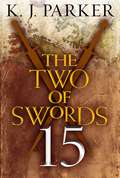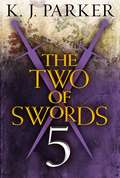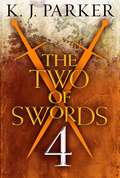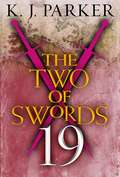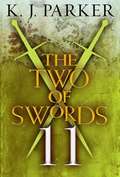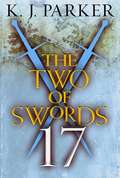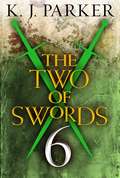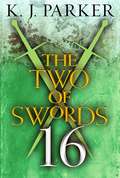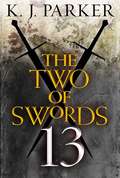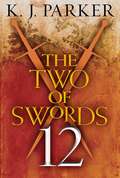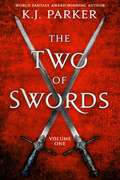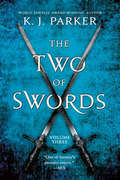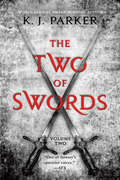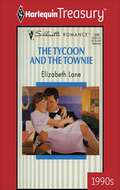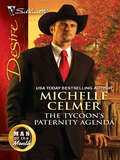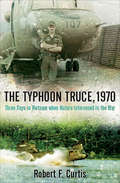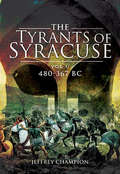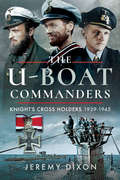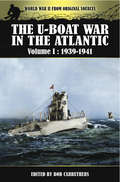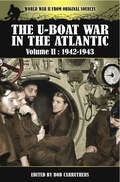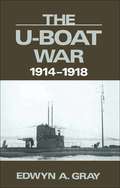- Table View
- List View
The Two of Swords: Part Fifteen
by K. J. Parker"Why are we fighting this war? Because evil must be resisted, and sooner or later there comes a time when men of principle have to make a stand. Because war is good for business and it's better to die on our feet than live on our knees. Because they started it. But at this stage in the proceedings," he added, with a slightly lop-sided grin, "mostly from force of habit." A soldier with a gift for archery. A woman who kills without care. Two brothers, both unbeatable generals, now fighting for opposing armies. No one in the vast and once glorious United Empire remains untouched by the rift between East and West, and the war has been fought for as long as anyone can remember. Some still survive who know how it was started, but no one knows how it will end. This serial novel from the World Fantasy Award winning K. J. Parker is the story of a war on a grand scale, told through the eyes of its soldiers, politicians, victims and heroes. The first three parts of The Two of Swords will arrive in April 2015, with further installments to be released monthly.This is the fifteenth installment in the Two of Swords serialization.
The Two of Swords: Part Five
by K. J. Parker"Why are we fighting this war? Because evil must be resisted, and sooner or later there comes a time when men of principle have to make a stand. Because war is good for business and it's better to die on our feet than live on our knees. Because they started it. But at this stage in the proceedings," he added, with a slightly lop-sided grin, "mostly from force of habit." A soldier with a gift for archery. A woman who kills without care. Two brothers, both unbeatable generals, now fighting for opposing armies. No one in the vast and once glorious United Empire remains untouched by the rift between East and West, and the war has been fought for as long as anyone can remember. Some still survive who know how it was started, but no one knows how it will end. This serial novel from the World Fantasy Award winning K. J. Parker is the story of a war on a grand scale, told through the eyes of its soldiers, politicians, victims and heroes. The first three parts of The Two of Swords will arrive in April 2015, with further installments to be released monthly.This is the fifth installment in the Two of Swords serialization.
The Two of Swords: Part Four
by K. J. Parker"Why are we fighting this war? Because evil must be resisted, and sooner or later there comes a time when men of principle have to make a stand. Because war is good for business and it's better to die on our feet than live on our knees. Because they started it. But at this stage in the proceedings," he added, with a slightly lop-sided grin, "mostly from force of habit." A soldier with a gift for archery. A woman who kills without care. Two brothers, both unbeatable generals, now fighting for opposing armies. No one in the vast and once glorious United Empire remains untouched by the rift between East and West, and the war has been fought for as long as anyone can remember. Some still survive who know how it was started, but no one knows how it will end. This serial novel from the World Fantasy Award winning K. J. Parker is the story of a war on a grand scale, told through the eyes of its soldiers, politicians, victims and heroes. The first three parts of The Two of Swords will arrive in April 2015, with further installments to be released monthly.This is the fourth installment in the Two of Swords serialization.
The Two of Swords: Part Fourteen
by K. J. Parker"Why are we fighting this war? Because evil must be resisted, and sooner or later there comes a time when men of principle have to make a stand. Because war is good for business and it's better to die on our feet than live on our knees. Because they started it. But at this stage in the proceedings," he added, with a slightly lop-sided grin, "mostly from force of habit." A soldier with a gift for archery. A woman who kills without care. Two brothers, both unbeatable generals, now fighting for opposing armies. No one in the vast and once glorious United Empire remains untouched by the rift between East and West, and the war has been fought for as long as anyone can remember. Some still survive who know how it was started, but no one knows how it will end. This serial novel from the World Fantasy Award winning K. J. Parker is the story of a war on a grand scale, told through the eyes of its soldiers, politicians, victims and heroes. The first three parts of The Two of Swords will arrive in April 2015, with further installments to be released monthly.This is the fourteenth installment in the Two of Swords serialization.
The Two of Swords: Part Nineteen
by K. J. Parker"Why are we fighting this war? Because evil must be resisted, and sooner or later there comes a time when men of principle have to make a stand. Because war is good for business and it's better to die on our feet than live on our knees. Because they started it. But at this stage in the proceedings," he added, with a slightly lop-sided grin, "mostly from force of habit." A soldier with a gift for archery. A woman who kills without care. Two brothers, both unbeatable generals, now fighting for opposing armies. No one in the vast and once glorious United Empire remains untouched by the rift between East and West, and the war has been fought for as long as anyone can remember. Some still survive who know how it was started, but no one knows how it will end. This serial novel from the World Fantasy Award winning K. J. Parker is the story of a war on a grand scale, told through the eyes of its soldiers, politicians, victims and heroes. The first three parts of The Two of Swords will arrive in April 2015, with further installments to be released monthly.This is the nineteenth installment in the Two of Swords serialization.
The Two of Swords: Part Seven
by K. J. Parker"Why are we fighting this war? Because evil must be resisted, and sooner or later there comes a time when men of principle have to make a stand. Because war is good for business and it's better to die on our feet than live on our knees. Because they started it. But at this stage in the proceedings," he added, with a slightly lop-sided grin, "mostly from force of habit." A soldier with a gift for archery. A woman who kills without care. Two brothers, both unbeatable generals, now fighting for opposing armies. No-one in the vast and once glorious United Empire remains untouched by the rift between East and West, and the war has been fought for as long as anyone can remember. Some still survive who know how it was started, but no-one knows how it will end. This serial novel from the World Fantasy Award winning K. J. Parker is the story of a war on a grand scale, told through the eyes of its soldiers, politicians, victims and heroes. The first three parts of The Two of Swords will arrive in April 2014, with further installments to be released monthly.This is the seventh installment in the Two of Swords serialization.
The Two of Swords: Part Seventeen
by K. J. Parker"Why are we fighting this war? Because evil must be resisted, and sooner or later there comes a time when men of principle have to make a stand. Because war is good for business and it's better to die on our feet than live on our knees. Because they started it. But at this stage in the proceedings," he added, with a slightly lop-sided grin, "mostly from force of habit." A soldier with a gift for archery. A woman who kills without care. Two brothers, both unbeatable generals, now fighting for opposing armies. No one in the vast and once glorious United Empire remains untouched by the rift between East and West, and the war has been fought for as long as anyone can remember. Some still survive who know how it was started, but no one knows how it will end. This serial novel from the World Fantasy Award winning K. J. Parker is the story of a war on a grand scale, told through the eyes of its soldiers, politicians, victims and heroes. The first three parts of The Two of Swords will arrive in April 2015, with further installments to be released monthly.This is the seventeenth installment in the Two of Swords serialization.
The Two of Swords: Part Six
by K. J. Parker"Why are we fighting this war? Because evil must be resisted, and sooner or later there comes a time when men of principle have to make a stand. Because war is good for business and it's better to die on our feet than live on our knees. Because they started it. But at this stage in the proceedings," he added, with a slightly lop-sided grin, "mostly from force of habit." A soldier with a gift for archery. A woman who kills without care. Two brothers, both unbeatable generals, now fighting for opposing armies. No one in the vast and once glorious United Empire remains untouched by the rift between East and West, and the war has been fought for as long as anyone can remember. Some still survive who know how it was started, but no one knows how it will end. This serial novel from the World Fantasy Award winning K. J. Parker is the story of a war on a grand scale, told through the eyes of its soldiers, politicians, victims and heroes. The first three parts of The Two of Swords will arrive in April 2015, with further installments to be released monthly.This is the sixth installment in the Two of Swords serialization.
The Two of Swords: Part Sixteen
by K. J. Parker"Why are we fighting this war? Because evil must be resisted, and sooner or later there comes a time when men of principle have to make a stand. Because war is good for business and it's better to die on our feet than live on our knees. Because they started it. But at this stage in the proceedings," he added, with a slightly lop-sided grin, "mostly from force of habit." A soldier with a gift for archery. A woman who kills without care. Two brothers, both unbeatable generals, now fighting for opposing armies. No one in the vast and once glorious United Empire remains untouched by the rift between East and West, and the war has been fought for as long as anyone can remember. Some still survive who know how it was started, but no one knows how it will end. This serial novel from the World Fantasy Award winning K. J. Parker is the story of a war on a grand scale, told through the eyes of its soldiers, politicians, victims and heroes. The first three parts of The Two of Swords will arrive in April 2015, with further installments to be released monthly.This is the sixteenth installment in the Two of Swords serialization.
The Two of Swords: Part Thirteen
by K. J. Parker"Why are we fighting this war? Because evil must be resisted, and sooner or later there comes a time when men of principle have to make a stand. Because war is good for business and it's better to die on our feet than live on our knees. Because they started it. But at this stage in the proceedings," he added, with a slightly lop-sided grin, "mostly from force of habit." A soldier with a gift for archery. A woman who kills without care. Two brothers, both unbeatable generals, now fighting for opposing armies. No one in the vast and once glorious United Empire remains untouched by the rift between East and West, and the war has been fought for as long as anyone can remember. Some still survive who know how it was started, but no one knows how it will end. This serial novel from the World Fantasy Award winning K. J. Parker is the story of a war on a grand scale, told through the eyes of its soldiers, politicians, victims and heroes. The first three parts of The Two of Swords will arrive in April 2015, with further installments to be released monthly.This is the thirteenth installment in the Two of Swords serialization.
The Two of Swords: Part Twelve
by K. J. Parker"Why are we fighting this war? Because evil must be resisted, and sooner or later there comes a time when men of principle have to make a stand. Because war is good for business and it's better to die on our feet than live on our knees. Because they started it. But at this stage in the proceedings," he added, with a slightly lop-sided grin, "mostly from force of habit." A soldier with a gift for archery. A woman who kills without care. Two brothers, both unbeatable generals, now fighting for opposing armies. No one in the vast and once glorious United Empire remains untouched by the rift between East and West, and the war has been fought for as long as anyone can remember. Some still survive who know how it was started, but no one knows how it will end. This serial novel from the World Fantasy Award winning K. J. Parker is the story of a war on a grand scale, told through the eyes of its soldiers, politicians, victims and heroes. The first three parts of The Two of Swords will arrive in April 2015, with further installments to be released monthly.This is the twelfth installment in the Two of Swords serialization.
The Two of Swords: Volume One (The Two of Swords #1)
by K. J. Parker"Why are we fighting this war? Because evil must be resisted, and sooner or later there comes a time when men of principle have to make a stand. But at this stage in the proceedings," he added, with a slightly lopsided grin, "mostly from force of habit."A soldier with a gift for archery. A woman who kills without care. Two brothers, both unbeatable generals, now fighting for opposing armies. No one in the vast and once glorious United Empire remains untouched by the rift between East and West, and the war has been fought for as long as anyone can remember. Some still survive who know how it was started, but no one knows how it will end. Except, perhaps, the Two of Swords.World Fantasy Award-winning author K. J. Parker delivers the first volume of his most ambitious work yet-the story of a war on a grand scale, told through the eyes of soldiers, politicians, victims, and heroes.
The Two of Swords: Volume One (Two of Swords #2)
by K. J. Parker'Parker's acerbic wit and knowledge of human nature are a delight to read as he explores the way conflict is guided, in equal measure, by the brilliance and unerring foolishness of humanity . . . . Thoroughly engaging.' - RT Books Reviews'Assassins, emperors, generals, rogues, farmboys-turned-hero - all the trappings of epic fantasy . . . [and] all the complexity you could ever desire' - PORNOKITSCHA soldier with a gift for archery. A woman who kills without care. Two brothers, both unbeatable generals, now fighting for opposing armies. No one in the vast and once glorious United Empire remains untouched by the rift between East and West, and the war has been fought for as long as anyone can remember. Some still survive who know how it was started, but no one knows how it will end. Except, perhaps, the Two of Swords.World Fantasy Award-winning fantasy author K. J. Parker delivers his most ambitious work yet - the story of a war on a grand scale, told through the eyes of soldiers, politicians, victims and heroes.Books by K.J. Parker:Fencer TrilogyThe Colours in the SteelThe Belly of the BowThe Proof HouseScavenger TrilogyShadowPatternMemoryEngineer TrilogyDevices and DesiresEvil for EvilThe EscapementSaloninusBlue and GoldThe Devil You KnowTwo of SwordsThe Two of Swords: Part 1The Two of Swords: Part 2The Two of Swords: Part 3NovelsThe CompanyThe Folding KnifeThe HammerSharpsSavagesSixteen Ways to Defend a Walled CityMy Beautiful Life
The Two of Swords: Volume Three (The Two of Swords #3)
by K. J. ParkerThe epic concluding volume in The Two of Swords trilogy by World Fantasy Award-winning author K. J. Parker."Why are we fighting this war? Because evil must be resisted, and sooner or later there comes a time when men of principle have to make a stand. Because war is good for business and it's better to die on our feet than live on our knees. Because they started it. But at this stage in the proceedings," he added, with a slightly lop-sided grin, "mostly from force of habit."A soldier with a gift for archery. A woman who kills without care. Two brothers, both unbeatable generals, now fighting for opposing armies. No-one in the vast and once glorious United Empire remains untouched by the rift between East and West, and the war has been fought for as long as anyone can remember. Some still survive who know how it was started, but no-one knows how it will end.The Two of Swords is the story of a war on a grand scale, told through the eyes of its soldiers, politicians, victims and heroes.
The Two of Swords: Volume Two (The Two of Swords #2)
by K. J. ParkerThe second volume in The Two of Swords trilogy by World Fantasy Award-winning author K. J. Parker."Why are we fighting this war? Because evil must be resisted, and sooner or later there comes a time when men of principle have to make a stand. Because war is good for business and it's better to die on our feet than live on our knees. Because they started it. But at this stage in the proceedings," he added, with a slightly lop-sided grin, "mostly from force of habit."A soldier with a gift for archery. A woman who kills without care. Two brothers, both unbeatable generals, now fighting for opposing armies. No-one in the vast and once glorious United Empire remains untouched by the rift between East and West, and the war has been fought for as long as anyone can remember. Some still survive who know how it was started, but no-one knows how it will end.The Two of Swords is the story of a war on a grand scale, told through the eyes of its soldiers, politicians, victims and heroes.
The Tycoon and the Townie
by Elizabeth LaneTHE WEALTHY MAN...Struggling single mother Kate Valera had spent most of her life with her nose pressed against the window, looking at how the other half lived. And then one day, she saw Jefferson Parish looking back at her. The wealthy widower was everything she'd always wanted...and known she couldn't have.Jeff touched something in Kate that had lain sleeping for so long, she wasn't sure it was still there. But he was used to a "certain kind of woman," Kate knew, and she-waitress uniform and all-was not exactly it. Was theirs only a summer romance-or would those autumn winds sweep them down the aisle?
The Tycoon's Paternity Agenda: The Tycoon's Paternity Agenda Ultimatum: Marriage Bossman Billionaire Master Of Fortune (Man of the Month #107)
by Michelle CelmerMr. December: Adam Blair, billionaire oil baron.Dream: Producing a much-wanted heir.Dilemma: Keeping the arrangement strictly business.The time had come to move on. CEO and widower Adam Blair was determined to find the right woman to carry his baby. And when Katy Huntly, his late wife's sister, discovered his plan, she demanded to be the surrogate. The agreement certainly made sense...on paper. Adam had always felt a certain pull toward Katy, and those feelings only intensified the closer they grew. But falling in love had no place in this tycoon's agenda. How could he imagine allowing their relationship to progress beyond nine months?
The Typhoon Truce, 1970: Three Days in Vietnam when Nature Intervened in the War
by Robert F. CurtisThis military history chronicles a time during the Vietnam War when fighting stopped and the 101st Airborne helped those in need during a natural disaster. For three days during the Vietnam War, it wasn&’t rockets or artillery that came through the skies, but a horrific force of nature that suddenly put both sides in awe. When Super Typhoon Joan arrived in October 1970, an unofficial truce began. Air crewman faced masses of Vietnamese civilians outside their base perimeters for the first time. Could we trust them not to shoot? Could they trust us not to drop them off in a detention camp? Truces never last, but while they do, life changes for everyone involved. The &“typhoon truce&” stopped the war for three days in northern I Corps—that area bordering the demilitarized zone separating South Vietnam from North. Then, less than a week later, Super Typhoon Kate hit the same area with renewed fury. As the entire countryside was flooded, the people faced war and natural disaster at the same time. No one but the Americans had the resources to help the people who lived in the lowlands, and so they did. The everyday dangers they faced were only magnified by low clouds and poor visibility. But the aircrews of the 101st Airborne went out to help anyway. In this book, we see how, for a brief period during an otherwise vicious war, saving life took precedence over bloody conflict.
The Tyrants of Syracuse Volume I: 480–367 BC (The Tyrants of Syracuse #1)
by Jeff ChampionVolume one of this sweeping history chronicles the turbulent ancient history of Syracuse from the rise of Gelon to the death of Dionysius I. Situated at the heart of the Mediterranean, Syracuse was one of the most important city-states of the classical Greek world. Coveted for its wealth and strategic location, it was caught in the middle as Carthage, Epirus, Athens and then Rome each battled to gain control of the region. The threat of expansionist enemies on all sides made for a tumultuous situation within the city, resulting in repeated coups and a series of remarkable tyrants, such as Gelon, Timoleon and Dionysius. In volume one of The Tyrants of Syracuse, Jeff Champion traces the course of Syracuse's wars from the Battle of Himera against the Carthaginians down to the death of Dionysius I, whose reign proved to be the high tide of the city's power and influence. Within this period, Syracuse heroically defeated the Athenian force that besieged them for more than two years—an event with far-reaching ramifications.
The Tyrants of Syracuse Volume II: War in Ancient Sicily, 367–211 BC (The Tyrants of Syracuse #2)
by Jeff ChampionThis is the story of one of the most important classical cities, Syracuse, and its struggles (both internal and external) for freedom and survival. Situated at the heart of the Mediterranean, Syracuse was caught in the middle as Carthage, Pyrrhus of Epirus, Athens and then Rome battled to gain control of Sicily. The threat of expansionist enemies on all sides made for a tumultuous situation within the city, resulting in repeated coups that threw up a series of remarkable tyrants, such as Gelon, Timoleon and Dionysius. In this first volume Jeff Champion traces the course of Syracuse's wars under the tyrants from the Battle of Himera (480 BC) against the Carthaginians down to the death of Dionysius I (367 BC), whose reign proved to be the high tide of the city's power and influence. One of the highlights along the way is the city's heroic resistance to, and eventual decisive defeat of, the Athenian expeditionary force that besieged them for over two years (415-413 BC), an event with massive ramifications for the Greek world. This is the eventful life story of one of the forgotten major powers of the ancient Mediterranean world.
The U-Boat Commanders: Knight's Cross Holders 1939–1945
by Jeremy DixonThis illustrated WWII reference guide presents detailed profiles of Nazi U-Boat commanders who were awarded the Knight&’s Cross. The Knight&’s Cross—or Ritterkreuz—was one of the highest decorations given for acts of valor among the German armed forces during the Second World War. When a U-boat captain was awarded the decoration, it was source of pride for his entire crew. Sometimes it was even added to the boat&’s insignia. In all, there were 123 recipients. In The U-Boat Commanders, Jeremy Dixon provides a highly illustrated guide to all these men and their wartime service. A detailed text accompanied by almost 200 archive photographs describes the military careers of each U-Boat Commander, including those who received the higher grades of the award. Full details are given of their tours of duty, the operations they took part in, how they won their award, how many ships they sank, and their subsequent careers.
The U-Boat War in the Atlantic, 1939–1941: Volume I: 1939- 1941 (World War Ii From Original Sources Ser.)
by Bob CarruthersFirst in the trilogy that covers WWII submarine warfare in the Atlantic from the German perspective—edited by the Emmy Award-winning historian and author. The U-Boat war is a unique visual record of Hitler&’s infamous submarine fleet and a grim account of those that lived, worked and risked their lives stalking the depths of the Atlantic and Mediterranean seas. This book analyzes the development of the U-boat, the recruitment and training, and reveals how the crews tried to destroy essential Allied supplies across the Atlantic and bring Britain to its knees. Using some 250 rare and unpublished photographs together with detailed captions and accompanying text, the book provides an outstanding insight into the various operations and the claustrophobic existence of the crew, where they lived in cramped and often deplorable conditions. It depicts how this potent force became one of the most dominant German fighting units during World War Two and became such a worry to Allied shipping that even Winston Churchill himself claimed that the &“U-boat peril&” was the only thing that ever really frightened him during the war. On their defeat hung the outcome of the war, and through courageous and determined resistance against overwhelming odds, the Allies eventually inflicted such catastrophic damage on the U-boats that the losses were too great to continue. Of the 38,000 men that went to sea onboard these deadly vessels, only 8,000 were to survive to tell the tale.
The U-Boat War in the Atlantic, 1942–1943: Volume Ii: 1942-1943 (World War Ii From Original Sources Ser.)
by Bob CarruthersThis is the fascinating account, as told from the German perspective, of the Battle of the Atlantic, the longest-running, continuous military campaign in World War II, spanning from 1939 through to Germanys defeat in 1945. At its core was the Allied naval blockade of Germany, which was announced the day after the declaration of war, although it quickly grew to include Germany's counter-blockade. The name "Battle of the Atlantic", was coined by Winston Churchill in 1941 and he famously stated that the U-boats were the only thing that really frightened him. The U-boat war encompassed a campaign that began on the first day of the European war and lasted for six years, involved thousands of ships and stretched over thousands of square miles of ocean, in more than 100 convoy battles and perhaps 1,000 single-ship encounters. In the 68 months of World War II, 2,775 Allied merchant ships were sunk for the loss of 781 U-boats.This is the story of that massive encounter from the German perspective. Published in three volumes, this work was compiled under the supervision of the U.S Navy Department and the British Admiralty by Fregattenkapitan Gunther Hessler. The author, though without previous experience as a writer, had first hand experience of U-boat warfare having commanded a U-boat in 1940 and 1941. For the remainder of the war he was Staff Officer to the Flag Officer commanding U-boats. He had access to German war diaries and other relevant documents concerning U-boat command, and this work based on these many documents, tells the story entirely from the viewpoint of that command. For this reason this work is essential reading for anyone interested in the history of World War II from primary sources and will be of enduring interest to those engaged in attempting to unravel the true nature of submarine warfare in World War II.
The U-Boat War in the Atlantic, 1944–1945: Volume Iii: 1944-1945 (World War Ii From Original Sources Ser.)
by Bob CarruthersThis is the second of three volumes covering the U-boat campaign in the Atlantic during the Second World War.This is the fascinating account, as told from the German perspective, of the Battle of the Atlantic, the longest-running, continuous military campaign in World War II, spanning from 1939 through to Germany's defeat in 1945. At its core was the Allied naval blockade of Germany, which was announced the day after the declaration of war, although it quickly grew to include Germany's counter-blockade. The name "Battle of the Atlantic", was coined by Winston Churchill in 1941 and he famously stated that the U-boats were the only thing that really frightened him. The U-boat war encompassed a campaign that began on the first day of the European war and lasted for six years, involved thousands of ships and stretched over thousands of square miles of ocean, in more than 100 convoy battles and perhaps 1,000 single-ship encounters. In the 68 months of World War II, 2,775 Allied merchant ships were sunk for the loss of 781 U-boats.This is the story of that massive encounter from the German perspective. Published in three volumes, this work was compiled under the supervision of the U.S Navy Department and the British Admiralty by Fregattenkapitan Gunther Hessler. The author, though without previous experience as a writer, had first hand experience of U-boat warfare having commanded a U-boat in 1940 and 1941. For the remainder of the war he was Staff Officer to the Flag Officer commanding U-boats. He had access to German war diaries and other relevant documents concerning U-boat command, and this work based on these many documents, tells the story entirely from the viewpoint of that command. For this reason this work is essential reading for anyone interested in the history of World War II from primary sources and will be of enduring interest to those engaged in attempting to unravel the true nature of submarine warfare in World War II.
The U-Boat War, 1914–1918
by Edwyn GrayA history of Germany&’s usage of submarine warfare during World War I, by the author of Operation Pacific. In 1914, U-Boats were a new and untried weapon, and when such a weapon can bring a mighty empire to the brink of defeat there is a story worth telling. Edwyn Gray&’s The U-Boat War is the history of the Kaiser&’s attempt to destroy the British Empire by a ruthless campaign of unrestricted submarine warfare. It opens with Germany&’s first tentative experiments with the submarines and climaxes with the naval mutiny that helped bring down the Kaiser. In between is a detailed account of a campaign of terror which, by April, 1917, had the British Empire on the verge of surrender. The cost in lives and equipment was staggering. On the German side, 4,894 sailors and 515 officers lost their lives in action; 178 German Submarines were destroyed by the allies; 14 were scuttled and 122 surrendered. According to the most reliable sources, 5,708 ships were destroyed by the U-Boats and 13,333 non-combatants perished in British Ships. World figures for civilian casualties were never released.The U-Boat War is a savage but thrilling account of men fighting for their lives beneath the sea, and of the boats that changed the face of naval warfare.
